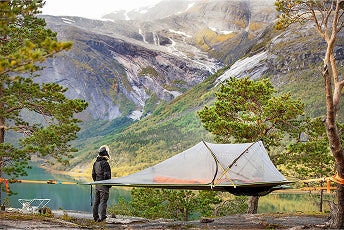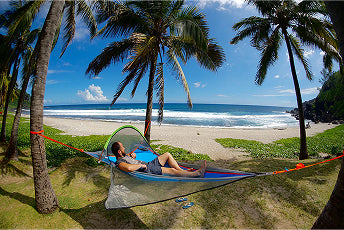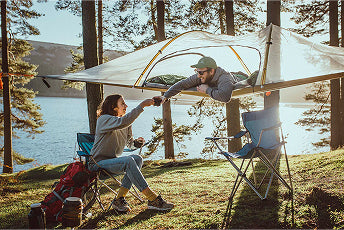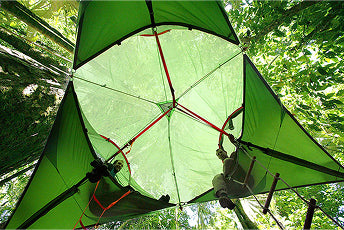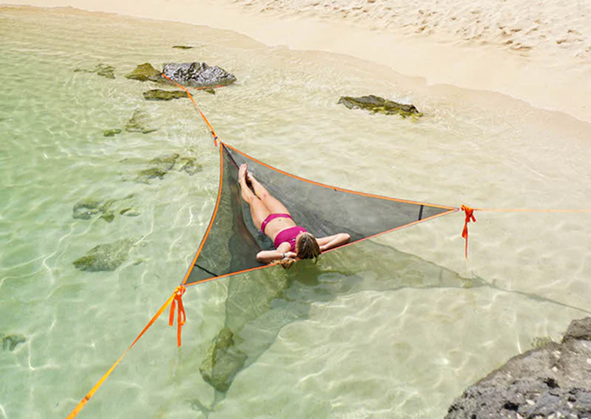
With so many lightweight camping options out there, it can be a minefield when trying to find the right solution for you and your backpacking trip. There are tents and hammocks of so many different sizes, shapes, weights, pack-size, hydrostatic head (waterproofness!) – you name the category, it’s out there - you can end up spending more hours trawling the internet for comparison sites and reviews than you do about planning your route and getting excited about being in the Great Outdoors. At which point, it sometimes feels easier to throw in your backpacking towel before you’ve even started.
But don’t give up just yet. This blog will help guide you through. Well, kind of. Or, at least, if nothing else, hopefully it will provide you with a bit of light relief as you make your own pre-backing, arduous journey through the world of comparison sites and a foray into what kit you need for the next trip. The aim of this blog is not to give a brand comparison. Clearly Tentsile is the best (…did I just say that?!)! No, the aim of this blog is to highlight the pros and cons of tent vs hammocks for backpacking. And, as mentioned earlier, if nothing else, if all we can offer you is a pit stop to have a rest on the road, to sit down for a momentary pause, to have a coffee and a chance to pick yourself back up for the rest of your trek through the internet’s Great Outdoor Gear Reviews sites, then there’s merit in that too!
A good place to start when looking at tents vs hammocks is whether you like ‘up’ or ‘down’? Hammocks go up; tents go down. Simple. Unless it’s a Tentsile, of course – which does both (but we can come on to this later!). Another question to ask yourself is do you like wobbly or do you like study? Hammocks wobble (swing side to side); tents are sturdy (rooted on the ground). Again, unless it’s a Tentsile (but we’re not trying to steal the show here…promise!).

These two questions start the journey with excitement. Then the conundrums come.
Hammocks are comfortable. No doubt about it! Being off the ground they can curve around your body. And the gentle swing from side to side? – well, who can deny it’s like rocking a baby to sleep (unless you suffer from seasickness! Then it’s not great!). Another fabulous benefit of the hammock is that you can see the world from your bed. Even hammocks with roofs most often have some space for you to look out. Also, hammocks are easy to put up. Hammocks are often cheaper, and easier to pack down. They can fit in your bag easier, making travel easier. They can be cooler on those balmy nights, as you have al fresco airflow. Hammocks allow you to camp on a range of terrains – flat ground is a little pedestrian for a Hammocker! - restrictive, limiting, unambitious. Hammocks allow you to adventure out and reach new heights. Literally! Indeed, there are lots of benefits of hammocks.
And yet what if there are no trees. Or other suitable posts (I was once spent four nights hammocked between posts on a boat going down the Rio Napo in Ecuador). That’s the end of the hammock dream. You do need trees or posts. That’s crucial. Also, hammocking is not allowed everywhere, so it might not be as carefree and adventurously spontaneous as your imagination might think. And there are other downsides too. You are more exposed in a hammock, and on those cold nights you might be colder as your body heat floats off into the night sky, both above you and below (although a Tentsile sleeping SkyPad can help with that particular problem! Again, not trying to steal the show!).
And so, maybe a tent is worth a revisit. The good old trusted on-the-ground tent. Never too traditional to be cast aside. Tents works. And as they say, if it ain’t broke… They provide cover, keep your heat in, you can sleep together with a fellow backpacker, there’s better protection against rain, you can store your gear inside, you can spread out a little. Yes, there’s lots about the ground tent that is worth considering. A tent brings you back down to earth, keeps you grounded. You know where you stand with a tent. No side to side, no thinking about trees or posts, how and where. Just find some ground and hit the sack!

But then there are poles to consider; they can break. Condensation is worse in a tent. Visibility is more restricted; you can rarely see the beauty of the Great Outdoors from inside a tent. Tents can get too hot. Tents trap insects (inside!). Tents are harder to pack down and travel with. What if the ground isn’t flat? And of course, you are closer to the creepy crawlies on the ground. Yes, there are issues with tents.
Really, you want something that fits in between a tent and a hammock. Something that does both. A tent that feels like a tent, but is off the ground. Hard not to say it, but that is exactly what a Tentsile is. But we’re not here to brag – and I will stick to my word that we’re not here to steal the show. So, putting aside the fact that a Tentsile clearly is the best option for backpacking (check out the UNA or the Flite, for example, with their ground conversation kits…shhh), there are lots of things to consider when picking between a tent and a hammock when planning a backpacking trip: think about your preferences, your experience, your skill, the type of trail you’re going on; all these things will affect your decision, and all these things will impact how much you enjoy your trip.
From our side – the Tentsile side – we just want you out and about, enjoying the Great Outdoors as best you can, for as long as you can, rather than being stuck behind a screen for longer than you need to. And on that note, my suggestion is you go and consider your options whilst taking a walk. Mull it over. Think it through. Ruminate a little. And whilst you do, think about how cool it would be to sleep in a tent that’s of the ground (…shh!).


